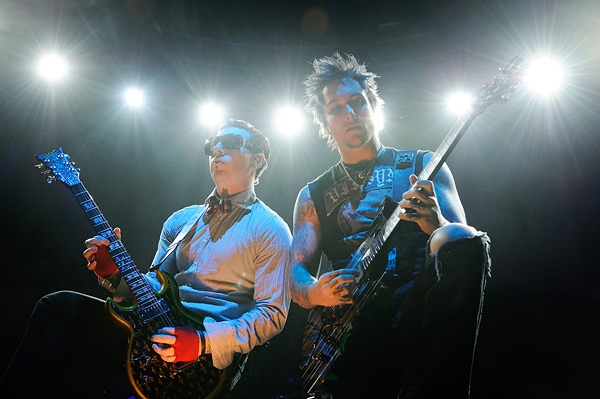
Stage lighting for live music is essential, not only to simply see the bands on stage, but also to enhance the music and create an atmosphere for the performance. With the charge of capturing the moments of a concert, live music photographers often have a love-hate relationship with lighting designers – praising bright, photogenic treatments and cursing red light in any form.
For anyone who's wanted insight into the world of lighting for concerts, professional lighting designer Ignacio Rosenberg has taken the time out of his tour schedule to give a peak into what goes into lighting everything from club shows to arena-fillers.
About Lighting Designer Ignacio Rosenberg
Ignacio Rosenberg is a Argentine-born lighting designer, DJ, and photographer. Rosenberg's skill as a lighting designer have made him hugely in demand in the realm of live music. As a result, he's traveled the world as a lighting designer for Bullet For My Valentine, Art Of Dying and the Taste Of Chaos tours. In addition, he's worked with acts such as Janet Jackson, R.E.M., Avenged Sevenfold, Neil Diamond, Disturbed, and more.
I met Ignacio in 2008 when he was working as the lighting designer for Bullet For My Valentine on the Taste of Chaos 2008 tour. All images used in this interview are examples of Rosenberg's work, including several images by Rosenberg himself.
Interview with Ignacio Rosenberg
My questions are in bold. Ignacio's answers follow in this format.
Thanks for taking the time to do this interview with us, Ignacio. First off – you're a world-traveled lighting designer who's worked with some huge names. How'd you break into the music industry and get involved with lighting performances?
Well my school in Argentina put up some very elaborate plays, and I remember back in 5th grade I had to act. Instead of looking at the audience, I was stuck looking backstage at the smoke machine. From there I decided sound consoles looked really cool, and I went to see Phantom Of The Opera in NY and that got me hooked onto doing pyro, and from there I ended up in sound and lighting.
I started working for a few companies and reading everything I could find about the industry and the technology and the art of it. I finished a degree in Electroacustical Design in Argentina and moved to the US to study Show Production and eventually got a job with my current employer.
In terms of the production for a show, what's the overall role and responsibilities of the lighting director, and how are those different than working as a lighting tech?
Well the lighting director is the lighting designer's eyes on the road. He makes sure the show looks every night how the designer envisioned it during rehearsals, so you're definitely mucho more into the artistic side of it. Lighting techs build the rigs and maintain it on a regular basis.
Some lighting directors don't mind giving a hand and will gladly work along the crew in the early mornings setting up, and some have earned the right to stay in the bus until later. Sometimes you're both.
What are some of the main concerns and challenges when it comes to lighting design?
That's a tough question, it depends on what you're designing. Corporate shows have an emphasis on the brand's image, live shoots (DVDs of concerts, etc) have to cover both performance lighting as well as camera lighting, touring shows have the band's input, the manager's input, set designers and nowadays more and more video designers.
Above all there's always a matter of budget, schedules and the reality of where these shows happen. Arenas and theatres demand very different rigs because of size and weight constraints.
In the end it's important to remember you're always lighting for someone else, you may have the biggest artistic vein in the world, but the lighting can never obscure what is going on on stage, that's usually a giant faux pas.
What thought process goes into color choices for lighting?
There are some “unwritten rules” for color. Some are very cliché like blues for ballads, but overall its a designers prerogative. Some bands don't like certain colors, or will refuse to be lit by a white followspot, while some songs have very distinct cues. What else would you do during Roxanne in the line “Turn on the red light” except piss off all the photogs with a massive red cue?
You have to keep it varied and you have to try and not repeat yourself too much. I try to keep songs in one or 2 color schemes to make them very separate from each other while some designers like to put a million colors per song.
You have to realize the human eye reacts to color based on impulse firing of the “cones and rods” inside your eyes, its a chemical reaction and it can get overused. If you run a red light show for too long the red isn't as spectacular as it was in the beginning because your eyes have gotten “tired” of looking at it, so you definitively have to keep things moving along.

How much does the artists' performance style factor into the work of lighting designers? Do artists regularly collaborate, give input and make requests?
Oh tons, we are after all lighting them. The minute you forget that is the minute you run out of a job. Lighting is meant to help out the band, not be the star of the show, it's not your name on the bill. You design based on what the band does and what they play. My friend Oli Metcalfe who is the lighting designer and director for Muse plays to their high-tech approach by using a lot of cutting edge gear and merging video and lighting; he does a great job at it, he really has that down. Nook has designed stuff for Kid Rock where he would have them build golden mirror balls and had to choose the best lights for the stripper poles! You are part of the performance but you're not all the performance, the band or artist is.
Yeah some artists are really involved. Linked to the question above, I remember reading an interview to ZZ Top's lighting designer where he was lighting a ballad with the usual blues and purples and one of the band members sat down and explained what the song was about and how they saw it as a warm song, not as a sad love-lost one, so he turned around and did all the songs in ambers and warm colors.
The guys in Bullet For My Valentine are all huge Iron Maiden fans so they like the big old par-can show, they need that “ballsy” lighting but that's all they give you, they give you the freedom to choose your own colors and positions…just don't make it look like an N'Sync show! Some have precise visions of what they expect and want and some have basic ideas and some don't really care, they know when its wrong and you work with them to change what's wrong. Drew Thomas (a great illusionist friend of mine from Florida) is really into the technology of it and he wants to know how the consoles work, what the gear is like, everything!
How would you characterize your own lighting style?
I'm usually very dark, I like shadows and weird angles and patterns. I'm very much in your face at the same time so I use strobes and really fat beams a lot. But everything changes based on what and who I'm designing, but I've done a lot of nightclubs and heavy metal in my life so that's what I try to stick to.
I know you're also an avid photographer. Does your eye as a photographer inform your work as a lighting designer, and vice versa?
I think as a photographer I've learnt how to light faces better, how to keep things even. I've had the great luck of working for a company that has let me work with some great designers, far more experienced and talented than me, but that also have been kind enough to teach me a lot, and especially those that work with live DVD and film shots have taught me a lot about how to balance front and back lighting for a camera and that also works very well live, maybe because we're so used to watching stuff on screens.
As a tech and a director I think that has had more impact on my photography, especially in live shows because I can get a feel of the timing and the balance of light. I remember the first Grad ND I bought was to compensate the show lighting with the followspot-lit artist, because if not you end up with either a greatly exposed artist with a dim rig, or a great rig with a really bright circle of overexposed artist.
Sometimes you want to put more emphasis on a look or on an artist, but its always better if you can do both at the same time. As an added bonus I have some great shots of bands because with an All Access pass I can go anywhere and don't' have to stick with the 3-song rule, and throughout a tour you learn where the biggest cues are and the best moments to shoot. I have insane shots of Mike Wengren playing drums from right behind his kit because, who else gets to go there during a show?
What are the most fun shows/tours to work? Are some genres more fun or challenging to light than others?
I think all tours have the capacity to be fun or a disaster and it always comes down to the team you have. I found out during the last Taste Of Chaos that all the band's albums were a lot weaker than their live performances, so on day one, I deleted my whole show for every band and changed everything because there was so much more energy on stage. It took a lot of faith from Nook Schoenfeld (the lighting designer for the tour) to just let me go out there and do what I wanted but it definitely put some extra pressure when I showed up and realized nothing really looked right the way I had done it. I did get many congratulations from managers and band members during the tour so I'd like to think I recouped very well. But the group of guys on that tour was great and we had a blast anyways.
Genres…I don't know I've moved in quite a small circle really, I think there are artists that are harder to work with and that usually comes down to either egos or their entourage of people around them. I think its always easier to light something that inspires you, I would personally find it very hard to light hip-hop because I'm so culturally distanced from it and the music doesn't appeal to me I'd have to really sit down and beat myself up to find how to do it. At the same time, without challenges life would be very boring.
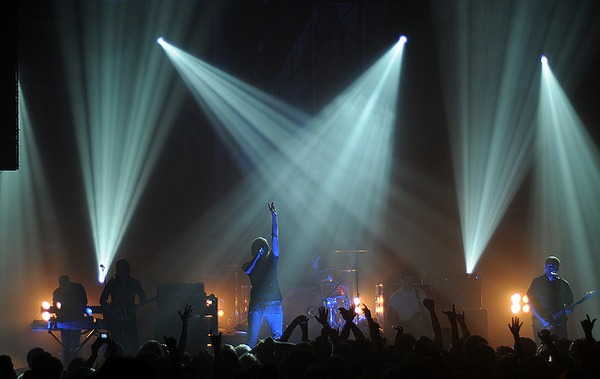
How much of lighting is done live and on the fly, and how much can be programed ahead of time?
Again it depends on the show. There are different levels of each. You can pre-program every song, verse and cue and then execute them live, you can do the same amount of work and have timecode trigger them automatically or you can program some preset looks, colors and positions (building blocks basically) and “punt” a whole show. Its what I ended up doing for Taste Of Chaos because it just worked very well with the bands and their directors and because it was a lot more fun to do.
Press are often limited to shooting the first three songs of most big tours. Often, it's just after those first couple songs that the lighting seems to get brighter and bigger. Is this just coincidence, or is there some grand conspiracy at work against photographers?
Oh terribly, we're thinking of actually putting some really bright lights aimed right at the cameras to give fake readings and underexpose everything.
No, you can't blow all your tricks on the first song, so most experienced designer build up, just like bands build up their set lists. Its just the natural order of things. You may have a big pop at the beginning of the show, but you really want people to go home remembering the massive finale while the band played their big hit, which usually also needs the best lighting.
Obviously, lighting is designed to look good to the paying customers – the audience. Are there also considerations for lighting that photographs well?
I don't know of any designers that do that, not for the live photogs at least. You do have to pay VERY close attention to that during live film shoots, but that's mostly for the cameras doing the video work. Some artists are very well given to lighting them evenly and bright, but the vast majority have a vision that clashes with that. The will never let you blast them with light because it would ruin the message they want to portray, especially for the sake of 3 songs. Proper photog lighting is the ream of studios.
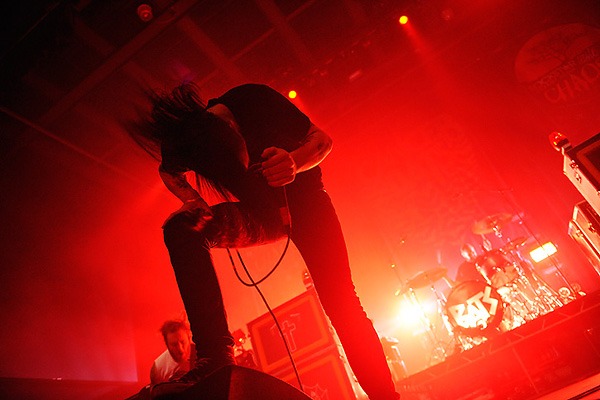
Red light. Music photographer's universally hate red concert lighting. What's up with red light at shows?
Well, red is used a lot, but its just because it is a very strong emotional color. It's something that produces a lot of strength and the human eye reacts strongly to it. That's not to say designers sit there and go “Well, chemically this will induce a huge response on the audience” but because they are seeing it, it produces a huge response on them.
You'll notice bigger shows with more experienced designers will limit red, because they know they will kill it if they overuse it, and because their eyes are more trained to it, and when they're programming they won't be as drawn to it as an unexperienced designer would be. I have a few set rules about this, I use red sparingly and I choose the songs to do it with; I leave red for those really strong songs.
Also, I try and light the band in something lighter, that comes from dance I think, you usually do ballet and your sidelights are a tone or 2 lighter than your backlights, or totally different, something that makes them stand out. So I'll go for a warm white (ie 3200K, incandescent) front light, or plain HMI light, or something along those lines, but I try to cool off the lighting on the artists.
I favor backlight a lot, something gaffers have taught me, and when I can I'll also add a backlight followspot or specials for the artists, to give them volume and pop them out of the environment I'm doing with the lights. But that is just me and different designers (and artists, and budgets) do different things.
Same with pure white looks, I'll edge to them as I go along a show, and the last song or 2 will have a lot of white, but if you do that at the beginning of the show, you've just killed everyone's eyes and blown it. Sometimes you can do it, but you can't have the massive white look at the beginning. Nine Inch Nail's tour a few years back started all white, but it was a very limited amount of light, a very sparse look. LeRoy Bennet is a genius and he found a way of making it look great and not assassinate the audience on the first number.
Green is a tricky color, it makes people look sick, and its hard to fit in sometimes. You have to watch it with green. Racially, shows with black people will have a lot warmer colors because they look terrible in green or blue, they disappear in the darkness and none of their highlights come up, I'd never front light a black artists with green. I'll avoid it as much as I can in those cases. Historically, a lot of the old incandescent lamps couldn't do cool colors very well, so it became a matter of having more lights will less colors (because you'd have to double the amount of blue lights, and green lights) or the same amount with more impact. Nowadays we mostly use arc sources and they do cold very very well.
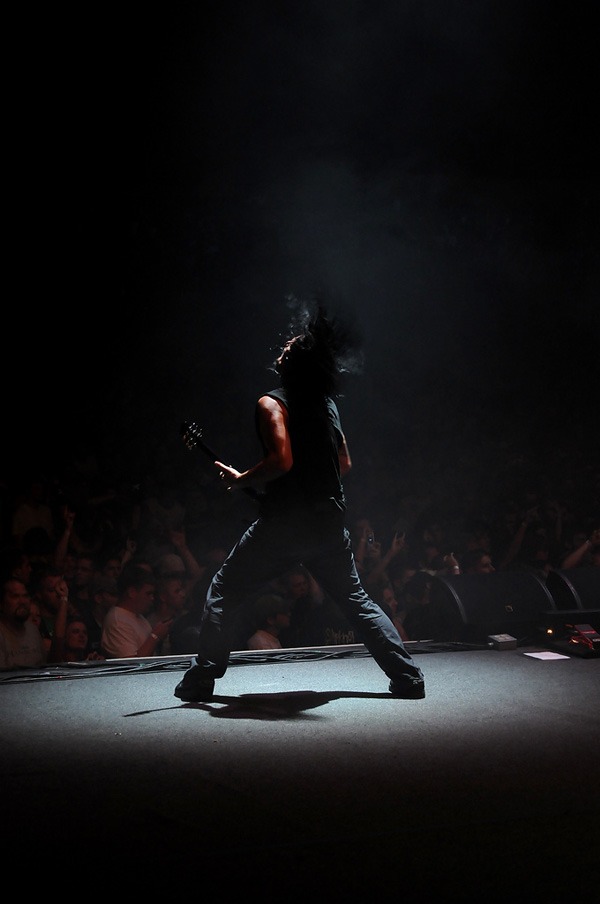
Flash is almost universally banned from live music photography. How do you feel about the use of flash in relation to stage lighting when it's allowed or photographers just break the rules?
In smaller shows it annoys me because you only have so much to get a certain look and atmosphere and a flash can blow it all up. I think artists probably don't like getting flashed in the face too much, especially from the angle where it comes with because it's where the audience is and where they're looking. I'm actually more upset with audience with flashes because all they do is light up the smoke in the air and get nonsense pictures. What flash will light up the artist from 200 feet away??
I know you have a pretty sweet collection of camera gear. What's your favorite piece of photo kit, and why?
Probably the Nikon D3s because it lets me crank the ISOs so high and get almost no noise, and a lot of show lighting (especially if I'm trying to shoot my own!) is too dark for ISO 100. Sometimes you just need that fast shutter speed to freeze an artist running across the stage. I've slowly amassed a collection of Leica R lenses that I've adapted to Nikon that give out great results but I rarely use them for shows because they're all manual focus, but they are definitely some of my nicest glass. Funny enough the first D3 I ever saw in real-life was on you, I think during Taste Of Chaos 2008!
You're on the road constantly, throughout the year and around the world. Favorite part of touring?
Seeing the world and getting paid to do so. Also a lot of what we do is kinda hardcore: we work silly hours, we work with stupid amounts of power and in heights and move a lot of weight up and down and its a bit of a niche and a small family. Its great running into old tour buddies in another tour, its a great way to start a tour.
Worst part of tour?
Some of those early hours, but lately…airports. They've become a giant pain but it comes with the territory.
The dream of a lot of music photographers is to work with a band on a world tour. Any advice for the road?
Don't think of the old stereotypical roadies of the 70s and 80s, nowadays there is a lot of responsibility out there equipment-wise and safety-wise. Its absolutely a unique job, but its also a lot of hard work. I've met some great touring photographers that chronicle the band's life on the road. I think people skill are THE most important in that position…probably why I'll never do it!
In terms of your colleagues, who's doing amazing work in the field now? What tours have amazing lighting that photographers and fans shouldn't miss?
Oh that's a tough one, because there are many designers around the world that I don't know about! I'm a huge fan of LeRoy Bennet's work (Paul McCartney, Tim McGraw, Faith Hill, Yanni and Nine Inch Nails), he has a really interesting quasi-industrial look to his stuff and just does some really great looks. Nook Schoenfeld (Kid Rock, Rihanna, Avenged Sevenfold and Disturbed) always puts on a very high-impact show and he's great fun to tour with too. Andi Watson (of Radiohead fame) is constantly pushing the envelope on technology and makes some awesome video/LED/color choices. There are a ton more: Baz Halpin (Pink, Ricky Martin, Tina Turner), Oli Metcalfe (Muse)…these are all tours and designers that the US would be able to see.
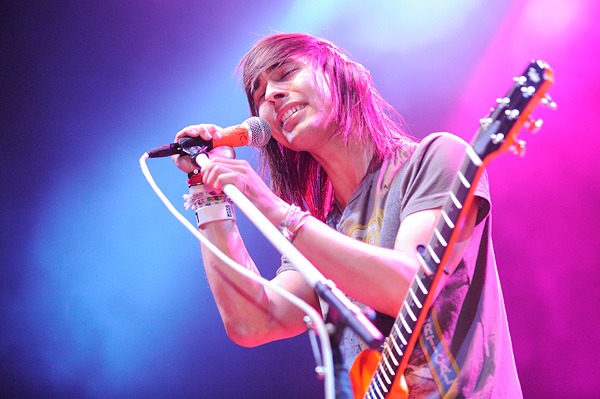
As a lighting designer, any parting words, warnings, or advice to all the live music photographers out there?
You know as a parting thought I think the best I have to offer is that until cameras give us the dynamic range of a human eye, or we shoot everything in HDR, nothing the camera will ever capture will be what the lighting guy is doing on stage. So you have to work around that, and find your own mood within it. A lot of my Slipknot pictures are a lot darker than the show was, but that was what I could take from the show lighting, so they're a bit creepier but they worked well with the band's image. I tend to be as dark of a photographer as I am a designer, I actually don't own a single flash head but I like sticking to what the stage has to offer, even if its not a natural color or angle, its what on stage and that is how I can represent it.
I'd have to say the biggest thing nowadays (especially for whoever the hell doesn't shoot in RAW) is to look at their white balance. We mix lights a lot, and whilst most moving lights are around 5000K, some are incandescent, and most conventional lights are as well. LEDs have their own thing, now we're getting more and more controlled temperatures on LEDs, with a few models that can change between warm and cold lighting. Some lights can dial up or down their temperature with graded CTO filters inside of them. So shoot in RAW and see what works best.
End Notes
Big thanks to Ignacio Rosenberg for taking the time for this interview!
Iggy has been kind enough to try and answer as many questions as he can in the comments section – so if you have additional questions you'd like answered, please leave a comment.







